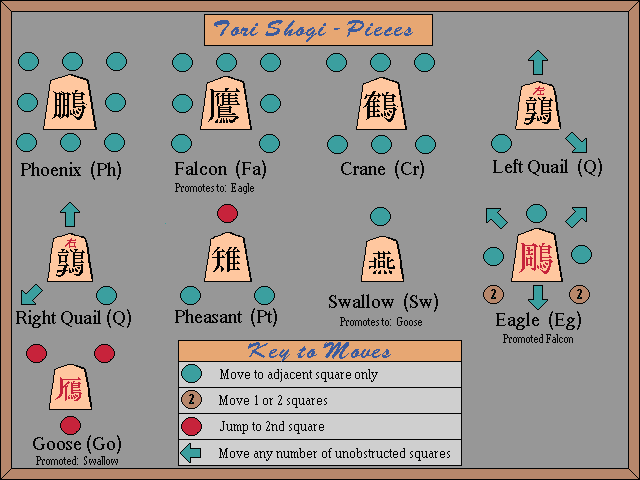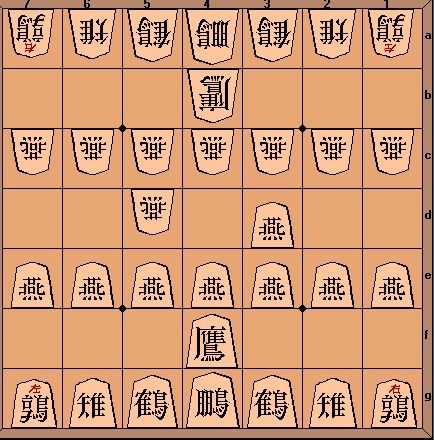Tori Shogi - Bird Shogi
Introduction
Tori Shogi is the smallest member of the Japanese family of chess games. The game dates from the end of the eighteenth century and is attributed to Ohashi Soei, a famous master of Shogi.
Tori Shogi literally means 'Bird Chess' and all of the pieces are named after birds.
Apart from Shogi itself (and possibly Wa Shogi), Tori is the only variant that is played with 'drops' (returning captured pieces into play), a feature which adds greatly to the appeal and depth of strategy of the game.
Play Tori Shogi against the computer through Jocly
The game
Tori Shogi is played on a board of 7 x 7 squares and each player has 16 pieces.
As in all Shogi variants the pieces are flat and wedge-shaped and are not distinguished by colour. Although the pieces are of uniform colour the first player is still conventionally referred to as 'Black' and the second player as 'White'. Ownership of the pieces is indicated by the direction in which they face, with a player's pieces always pointing towards the opponent.
The players make alternate moves, with the object being to capture the opposing 'Phoenix'. When a 'Phoenix' is about to be captured next move and no legal move can be made to prevent the capture, the piece is said to be 'Checkmated'.
On each turn a player can either:
- move one piece according to its power of movement to a vacant square on the board, or to a square occupied by an enemy piece (in which case the enemy piece is captured and removed);
- 'Drop' (re-enter) a previously captured piece on almost any vacant square.
or,
The pieces
The diagram below provides the names, notation symbols, promotion details, and powers of movement for all of the pieces in the game.

The next diagram shows the starting setup:
 Player
1 (white):
Player
1 (white):
Phoenix d1; Quail a1, g1; Pheasant b1, f1; Crane c1, e1; Falcon d2; Swallow
a3, b3, c3, d3, e3, e4, f3, g3,
Player 2 (black):
Phoenix d7; Quail a7, g7; Pheasant b7, f7; Crane c7, e7; Falcon d6; Swallow
a5, b5, c5, c4, d5, e5, f5, g5.
Jumping pieces
The 'Goose' and 'Pheasant' are the only pieces in Tori Shogi that have the power to jump over occupied squares. Both can jump to the second square in the directions indicated with red circles on the diagram above. The 'Eagle' can move to the second square in the reverse diagonal directions only if the first square is vacant (ie: it can not jump).
Promotion
Each player has a Promotion Zone consisting of the two ranks (rows of squares) furthest away from him.
Whenever a 'Swallow' or 'Falcon' makes a move wholly or partly within the Promotion Zone the piece assumes its promoted rank. The 'Swallow' promotes to a 'Goose' and a 'Falcon' becomes an 'Eagle'.
It should be noted that unlike in Shogi, promotion is compulsory.
As in other Shogi games, in Tori sets the promoted rank is shown on the reverse side of the piece, and the piece is turned over on promotion to reveal the new rank.
Captures
A captured piece is removed from the board and is held by the capturing player. The held piece (which is said to be 'in-hand') may subsequently be 'dropped' back into play on the side of the player who made the capture.
'Eagles' and 'Geese' revert to their unpromoted ranks when captured.
Drops
In place of a move a player may elect to 'drop' a piece held in-hand back into play. Pieces other than 'Swallows' may be returned to play on any vacant square.
The following restrictions apply to drops involving 'Swallows'. A Swallow may not be dropped:
- on the last rank (that furthest from the player),
- in any file (column of squares) already containing two unpromoted 'Swallows' of the same side,
- directly in front of the opposing 'Phoenix' so as to give instant 'Checkmate'.
A 'Swallow' or 'Falcon' that is dropped inside the player's Promotion Zone is not promoted until after it has made a further move on the board.
Repetition of moves
If the same position occurs three times by repetition of moves, the player starting the sequence must vary his move.
Handicap play
As in Shogi, a player of Tori may offer a handicap of one or more pieces to an opponent of less strength.
The player giving the handicap plays 'White' and his opponent (as 'Black') removes the handicap pieces as the first move of the game. In handicap play 'White' therefore makes the first move on the board.
Pieces removed as a handicap are totally removed from play and are not held in-hand by 'Black'.
Written by Steve Evans. Most of these texts are from his very nice free Shogi Variants program, a program that can be used to play many shogi variants with two players and gives the rules of these. Also, the images are obtained from taking screen-dumps of his program, with small modifications.
The information on this game was based on a the excellent description of many Shogi Variants, made by George Hodges. Mr. Hodges sells booklets with rules and information on the known historic shogi variants, and sells sets with which these variants can be played. Information and address of Mr. Hodges.
Small changes and additions to the texts of Steve Evans were made by Hans Bodlaender.
WWW page created: November 13, 1997.
